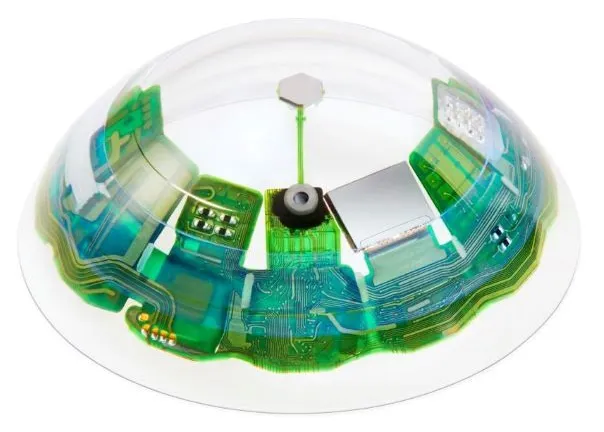Mojo
The basis for the Mojo Lens is a Micro-LED display that is less than 0.5mm (<1/50th of an inch) and has a PPI (Pixels/inch) of 14,000. To gain some perspective, an Apple (AAPL) iPhone 13 has a PPI of 460 and the highest PPI we can remember seeing was 807 on the Sony (SNE) Xperia XZ Premium that was released in 2017. A 4K UHD 65” TV has a PPI of 68, and a similar sized 8K TV has a PPI of 136, and the Mojo Lens display has a space between each pixel of 1.8µm, which is ~1/4 of the size of a human red blood cell, so you get the idea that there are a lot of Micro-LEDs squeezed into a very small space. As the display can do little on its own, there has to be a backplane of circuitry behind each pixel that controls them, along with micro-optics that shape the display image to the eye itself. This gives the system the ability to project text, graphics, and high resolution images on the user’s retina, which would be visible in any lighting situation, including when the user’s eyes are closed.
As we have noted before, there are a number of issues that make VR uncomfortable or even impossible for a segment of potential users, one of which is latency, or an inability of the system to keep the focus point of the image where the user is looking. If the image does not track to the eye movements of the user, the brain begins to get confused and fatigue or more serious problems begin to occur, which makes tracking a user’s movements a key to a practical device. The Mojo Vision prototype not only tracks using the usual accelerometer, gyroscope and magnetometer sensors that are familiar to AR/VR users, but uses a proprietary motion sensing algorithm that the company says is orders of magnitude more precise than current leading AR/VR optical eye-tracking systems and also contains 5G I/O and a 32 bit ARM Cortex-M0 processor.
Of course, all of this micro-hardware needs power, which means there is also a medical grade micro-battery and power management circuitry built-in to the Mojo Vision lens and a necklace worn by the user, which is designed to run the system all day and be wirelessly charged when removed. The final product will have to undergo FDA clinical trials for safety and reliability, but when it comes down to a device like this the biggest question becomes, “What will it be used for?” The eye-tracking features let the user interact with AR data or images just by moving visual focus so we know there will be interest in such a product from the retailing sector, where a user could look at an item, see how it might fit in a room, get specific item data, and by some means, such as a blink or nod, purchase the item within a few seconds. However there are a number of other uses that might have less financial significance but could provide considerable help to users.
One such would be in sports training, where athletes would not have to look at a band or display and lose performance focus during training. The company has partnered with Adidas (ADS.GR), Trailforks (pvt) for cycling, Wearable X (pvt) for yoga, Slopes (pvt) for skiing, and 18Birdies (pvt) for golf all relating to sports venues, while doctors being able to see patient data during an operation or in an ER without having to look at a device, screen or ask for information. However the visually impaired, a group of ~12m in the 40 years or older category in just the US, face little help from most modern wearable solutions, such as headsets that feed the user audio information as to what he or she is looking toward, would certainly benefit from a development like the Mojo Vision Lens, which could help to augment sight related information to those who have impairments. To that end the company has partnered with Menicon (7780.JP), Japan’s largest contact lens manufacturer to expedite the eventual trip through the FDA, and is expected to be testing the device on visually impaired subjects later this year.
The Mojo Vision Lens is still in development but as noted has recently reached the prototype stage. There are still many issues to be resolved and regulatory goals to be met, but we are always intrigued by a practical application of a display technology, in this case Micro-LED, and one that does not force the user to stand out because of an external device. Most of the other ‘electronic’ contact lens systems we have seen are more oriented toward drug delivery than augmented reality or improved vision so it is encouraging to see continued funding and actual progress toward such a product, and while the company is quite careful about releasing details, and rightly so, they seem to be on track toward a commercial product within a few years. Hopefully the display technology will also improve during that time and higher resolution and less costly Micro-LED displays will be available when the device goes into commercial production.


 RSS Feed
RSS Feed